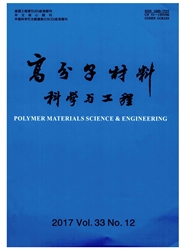

 中文摘要:
中文摘要:
以机械活化30min木薯淀粉(C30-St)和丙烯酰胺(AM)为主要原料,采用反相乳液法合成C30-St与AM接枝共聚物(C30-St-g-PAM),并通过红外光谱、扫描电镜、X射线衍射、热分析等手段对接枝共聚物进行结构分析和聚合机理探讨。实验结果显示,AM成功接枝于C30-St上;C30-St-g-PAM具有网状多孔洞结构,共聚反应在淀粉的无定型区和结晶区同时发生,反应不属于表面控制模型;共聚反应改变了原淀粉的聚集状态,接枝产物基本上为无定型的聚集态结构;热稳定性比原淀粉接枝共聚物(C-St-g-PAM)增强;C30-St-g-PAM的粒度一般在15μm~30μm。
 英文摘要:
英文摘要:
The mechanically-activated cassava starch acrylamide graft copolymers (C30-St-g-PAM) were synthesized by inverse emulsion polymerization with mechanically-activated 30 min cassava starch and acrylamide as raw materials. The structures of C30-St-g-PAM were characterized with Fourier transform infrared spectroscopy (FT-IR),differential scanning calorimetry (DSC),X-ray diffraction (XRD) and scanning electronic microscope (SEM). Meanwhile,the graft copolymerization mechanism in the inverse emulsion was discussed. The results show that polyacrylamide (PAM) is successfully grafted onto the mechanically-activated starch; C30-St-g-PAM are found to have a porous mesh-like structure with the graft-copolymerization reaction occurring at both crystalline regions and loose amorphous regions of the starch particle,which is not in agreement with the mechanism of surface control reaction. The aggregation phase of starch is changed from semicrystalline state to amorphous aggregation state due to the graft reaction of starch and acrylamide. However,the thermal stability of C30-St-g-PAM is higher than that of C-St-g-PAM. The size distribution is 15 μm~ 30 μm.
 同期刊论文项目
同期刊论文项目
 同项目期刊论文
同项目期刊论文
 期刊信息
期刊信息
